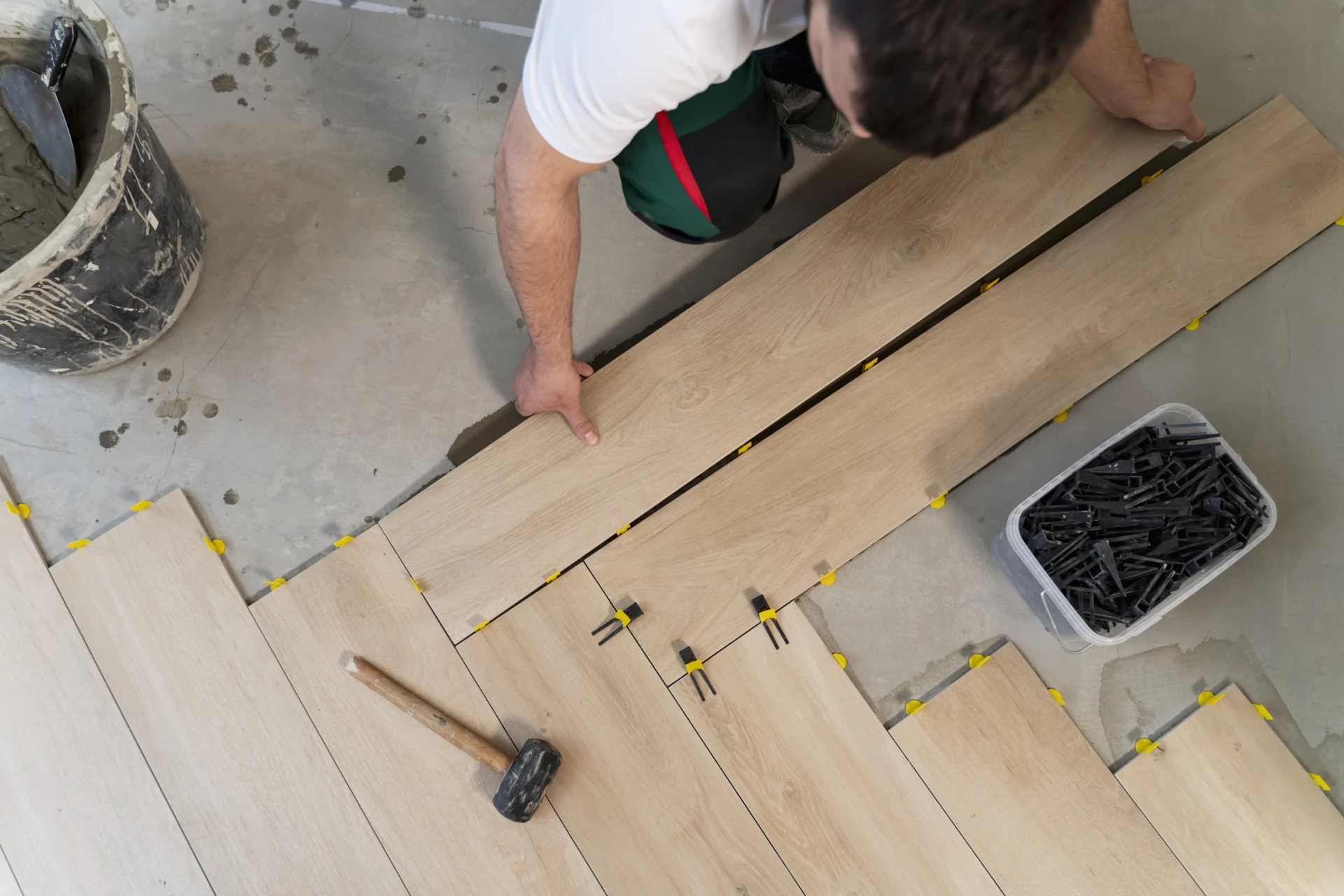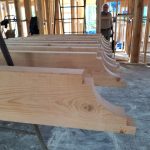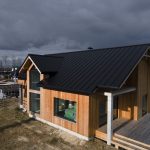
What are the different types of flooring materials?
What is engineered hardwood flooring: basics
If you’ve ever asked, what is engineered hardwood flooring, you’re in great company. In essence, it’s a modern take on classic wood floors, giving you the timeless beauty of hardwood but with added stability and better moisture resistance. According to Brewer Custom Floors, each plank includes a real hardwood veneer on top plus multiple layers of plywood beneath. These layers are stacked in alternating directions to combat expansion and contraction from humidity changes. It’s a smart option to consider when asking, what are the different types of flooring materials that combine both style and practicality.
Good news, you get many of the benefits of solid hardwood while sidestepping some of its drawbacks. Engineered hardwood floors can stand up to busier homes, frequent foot traffic, or rooms that tend to get a little damp, such as kitchens. In fact, many manufacturers use a “click-and-lock” system that makes installation faster and cleaner—without as much fuss over nails or glue. Because the plywood core is layered strategically, the planks often resist warping and buckling from changes in temperature.
If you’re comparing flooring types to see what works best in your rooms, take a look at what are the different types of flooring materials. That resource offers broader insight into popular options, including tile, laminate, and more natural materials. For now, let’s explore how engineered hardwood flooring stands apart from solid hardwood, why its wear layer matters, and how you can manage the installation process smoothly.
Compare solid and engineered hardwood
Solid hardwood flooring is exactly what the name suggests: it’s a single, solid plank milled from a particular tree species. Because it’s uniform from top to bottom, you can sand it down many times over decades—sometimes as many as ten refinishes if the plank is thick enough. Solid hardwood can last anywhere from 80 to 100 years, or even longer, depending on proper care and environmental factors.
Engineered hardwood shares the same top-layer species as solid wood, meaning you’ll get the look and texture of, say, oak or maple. However, the big difference is underneath that top veneer. Instead of a solid strip, you have multiple layers of plywood or other composite materials (like high-density fiberboard). This layered structure brings greater stability, as each ply is oriented at a 90-degree angle to the one below. The result? Engineered flooring handles seasonal changes in humidity better than solid wood, making it an appealing choice for basements, kitchens, and laundry areas. It’s also compatible with the floating floor installation method, which speeds up installs and reduces the need for adhesives or nails.
Focus on wear layer and refinishing
One factor that sets engineered hardwood flooring apart is the thickness of its wear layer. Thicker wear layers (up to 4–5 mm) allow multiple refinishing sessions, ideal for high-traffic areas. Thinner layers (1–2 mm) suit low-traffic spaces but offer limited refinishing. For more options, check out the different types of flooring materials.
Prepare for installation
Once you’ve picked the right engineered hardwood flooring, it’s time to prep for installation. Engineered planks offer flexible options—floating, glued, or nailed—making them easier than solid wood to install. The floating method is especially DIY-friendly, though many still hire a flooring contractor for best results.
Before installation, handle the basics: prep the subfloor, allow 24 hours for acclimation, and add underlayment if needed. Whether floating or fastening the boards, keep seams staggered. Once installed, just clean up and enjoy your new floor.
Explore pros and cons
Engineered hardwood flooring brings a unique balance of pros and cons you’ll want to weigh before you commit:
Pros:
- Stability in moisture-prone or heavily trafficked rooms
- Lower tendency to expand or contract, helping prevent warping
- Often less expensive than solid hardwood
- Variety of installation methods (floating, glue, or nails)
- Wide range of finishes, wood species, and plank sizes
- Potential for multiple refinishes if the wear layer is thick
Cons:
- Fewer total refinishing cycles than solid hardwood
- Certain low-cost versions may have very thin veneers
- Excessive flooding or standing water can damage the core
- Not all brands offer the same quality or thickness
What is engineered hardwood flooring—and what are the different types of flooring materials?
By now, you’ve seen that engineered hardwood flooring is a refined and highly practical alternative to solid wood. It layers a genuine slice of hardwood over a core designed for stability, moisture resistance, and long-lasting performance. You get a natural appearance, sturdiness underfoot, and often a lower price tag than you’d see with solid planks of the same species. It’s easy to see why engineered options rank among the best flooring materials for homes—they offer beauty, function, and versatility. You can also fine-tune your selection by choosing the thickness of the wear layer, which directly impacts how many times you can sand and refinish your floor. Thicker layers bring added years of life, while thinner versions still look amazing but may not endure as many refinishing rounds. Either way, the well-crafted design fits many rooms.
Ready to Install Engineered Hardwood Flooring?
If you’re excited to upgrade your space with engineered hardwood but want expert help choosing the right materials, prepping your subfloors, or getting professional installation—we’ve got you covered. At Mazz Construction, we bring years of experience and a full range of flooring solutions tailored to your style and budget.
Schedule your free consultation today and let our team help you transform your home with the perfect engineered hardwood flooring.
Frequently asked questions
1. What Are the Different Types of Flooring Materials?
There’s a wide range to choose from, each with its own pros and cons. Common types of flooring installation materials include hardwood, engineered wood, laminate, vinyl, tile, and carpet. The best choice depends on your space, lifestyle, and budget. For a complete breakdown and installation options, visit our flooring sales and installation service page.
2. What Is Engineered Hardwood Flooring?
Engineered hardwood flooring consists of a real wood veneer over multiple plywood layers, offering the classic look of hardwood with improved resistance to moisture and shifting. If you’re asking what is engineered hardwood flooring, it’s a smart blend of form and function. For more insights and tailored flooring upgrades, check out flooring sales and installation by Mazz Construction.
3. What Is Laminate Flooring?
Laminate flooring is a budget-friendly, durable alternative that mimics wood, tile, or stone through a printed photographic layer under a protective wear coat. It’s known for being DIY-friendly, thanks to its easy click-lock installation system. Curious how it fits into your next remodel? Explore more on our flooring services page.
4. What about moisture and humidity?
Engineered hardwood handles changes in humidity better than solid hardwood. The layered construction means less warping and buckling, making it a great fit for kitchens, basements, or places with temperature swings.
5. Should you acclimate engineered hardwood?
Absolutely. While it doesn’t expand or contract as much as solid wood, it still needs at least 24 hours to adjust to the room’s temperature and humidity before installation.
6. Do you need underlayment for engineered hardwood?
Yes. Underlayment helps manage moisture, reduce noise, and fix slight imperfections in the subfloor. If your planks don’t come with an attached underlayment, you’ll want to install one.
7. Is installation difficult?
Many people find it manageable, especially with a floating or click-and-lock system. That said, hiring a professional flooring contractor ensures accurate, efficient results if you’re not comfortable doing it yourself.
Key takeaways
- Engineered hardwood pairs genuine wood veneers with layered cores for enhanced stability.
- Thicker wear layers offer more refinishing opportunities.
- Floating installation is often simpler, but you may prefer gluing or nailing.
- Proper underlayment and acclimation are crucial for a successful install.
- It’s a budget-friendly way to enjoy classic hardwood beauty without some of solid wood’s challenges.




